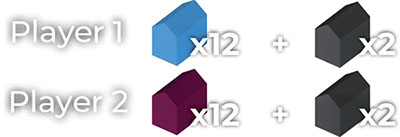
When playing with only one other player, play continues similarly, with one twist: as well as their regular houses, each player has 2 Powerhouses they can use to give themselves an edge.
When setting up, give one player 12 Purple houses, and the other player 12 Blue houses. Then, each player takes 2 Black houses - their Powerhouses.

On any turn the players can place a Powerhouse instead of a house of their color, according to the following rules:
Powerhouses can only be played along the walls (i.e. on the outer city house slots)
There can only be one Powerhouse on a given hex (for example if a Powerhouse is placed between the Architect and the Silversmith, no other Powerhouses can be placed next to those hexes)
Powerhouses don't require stone or wood to build (i.e. you can place a Powerhouse on a city area even if you already have as many houses there as you have stone)
Powerhouses only trigger the city actions, and don't provide resources (i.e. you don't get Olive, Grapes or Fish when you place them)
The player that places a Powerhouse will get all the actions from the hexes where the house was placed, regardless of the color of the houses already placed them (i.e. if the Purple player places a Powerhouse on the Wharf and there is already 1 Purple and 2 Blue houses there, the Purple player can sell four times and the Blue player gets no sales)
When a regular house is placed on an area that already has a Powerhouse, the Powerhouse's activation goes to the current player, as if the house was in their color
When counting the longest wall, Powerhouses are counted as a third color and break walls (unless one player has also a tower on the same space).
Continue Reading
